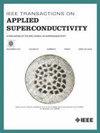AC Loss Characteristics of High-Temperature Superconducting Tapes Under Over-Current Conditions
IF 1.7
3区 物理与天体物理
Q3 ENGINEERING, ELECTRICAL & ELECTRONIC
引用次数: 0
Abstract
The transport current of high-temperature superconducting tapes depends on the critical current value. The upper limit of the transport current is determined by the ratio of the load to the critical current value. In general, direct current must not be regularly energized above the critical current. However, unforeseen events or accidents may result in instantaneous over-currents. This test could be conducted under sufficient cooling; however, the temperature increase causes the critical current value to decrease. Consequently, the loss increases rapidly, resulting in superconducting tape burning out. Conversely, burnout can be prevented under sufficient cooling. This study aimed to investigate the alternating current (AC) loss characteristics by experimentally applying AC above the critical current value of high-temperature superconducting tapes. ReBCO tapes with varying protective layer thicknesses and Bi2223/Ag tapes with different critical current values were subjected to immersion cooling in liquid nitrogen. The four-terminal method was employed to measure the flow of AC above the critical current value. Based on the findings, with adequate cooling, high-temperature superconducting tapes were stably energized even beyond the critical current value.求助全文
约1分钟内获得全文
求助全文
来源期刊

IEEE Transactions on Applied Superconductivity
工程技术-工程:电子与电气
CiteScore
3.50
自引率
33.30%
发文量
650
审稿时长
2.3 months
期刊介绍:
IEEE Transactions on Applied Superconductivity (TAS) contains articles on the applications of superconductivity and other relevant technology. Electronic applications include analog and digital circuits employing thin films and active devices such as Josephson junctions. Large scale applications include magnets for power applications such as motors and generators, for magnetic resonance, for accelerators, and cable applications such as power transmission.
 求助内容:
求助内容: 应助结果提醒方式:
应助结果提醒方式:


